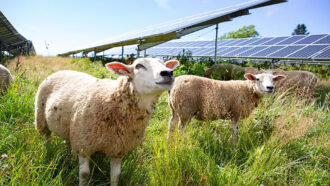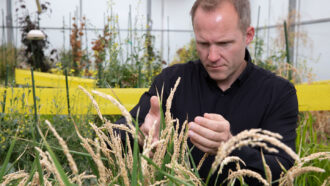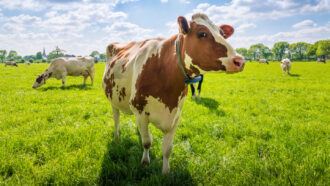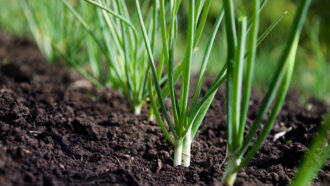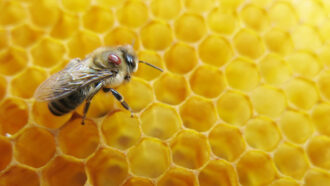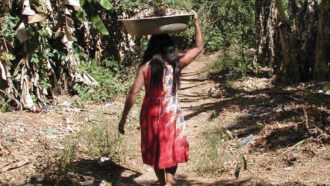Teen converts water pollutant into a plant fertilizer
A teen designed a way to reduce, reuse and recycle nutrients for plants
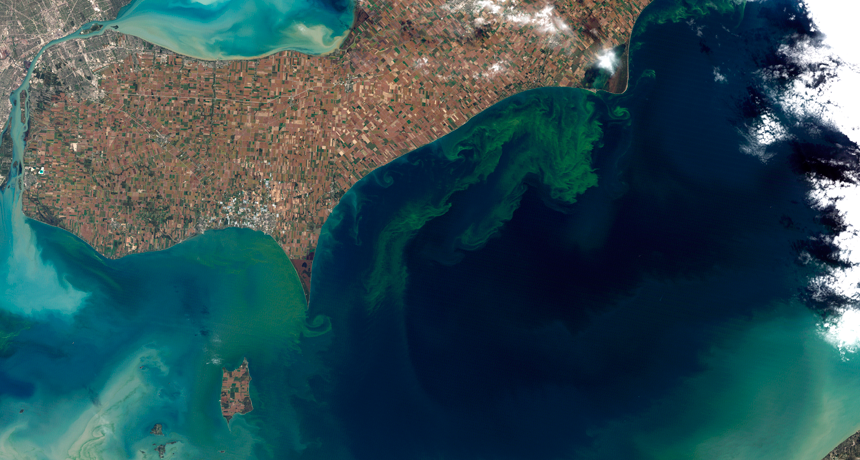
Excess phosphate fertilizer that washes off of farms can become a water pollutant that fuels the growth of algae. The green swirls near center of this 2011 image of Lake Eric show one such bloom.
Jesse Allen and Robert Simmon/NASA Earth Observatory/Wikimedia Commons
WASHINTON, D.C. — Farmers fertilize their crops to increase the size of their harvests. But when they use too much fertilizer, some of it runs off into nearby rivers and lakes. That can be a danger to the life there. Stefan Wan, 17, developed a method to soak up some of this excess before it can cause harm. And his method doesn’t just soak up those chemicals — it also releases them. That means the fertilizer can be used again.
The senior at Alexander W. Dreyfoos School of the Arts in West Palm Beach, Fla., showed off his fertilizer-recycling technique at the Regeneron Science Talent Search. Each year, this competition brings 40 seniors together from around the country to show off their science projects to the public. The teens also compete for almost $2 million in prizes. The competition is run by Society for Science & the Public and sponsored by Regeneron, a company that develops medicines. (Society for Science & the Public also publishes Science News for Students and this blog.)
Stefan has always had a science-filled life. His mother, Jianchang Cai, is an engineer, and his father, Yongshan Wan, is a scientist who studies soil. But the teen didn’t become passionate about science until 10th grade, when he took chemistry. “I fell in love with the subject and wanted to do more with it,” he says. He wanted to use his newfound love of chemistry to solve an environmental problem. The teen just needed the right problem.
And he found one close by. The farms near his hometown of Wellington, Fla., fertilize their crops with nitrate and phosphate — two chemicals that plants need to grow. When it rains, any excess fertilizer can run off into nearby waterways. There, those nutrients may fuel an explosive growth of algae, known as a bloom. When the blooms later die, bacteria will break down the algae. This will fuel the growth of the bacteria, which need oxygen to do their work. The oxygen they use can leave less for fish and other living things, causing many of them to suffocate and die. This process is known as eutrophication (YU-trow-fih-KAY-shun).
Several blooms occurred in the summer of 2016 on the Caloosahatchee River in Stefan’s home state. The teen thought he might be able to help prevent future blooms by developing a method to absorb some of the fertilizer that runs off farms. His father helped him get in touch with Yuncong Li, a scientist who studies soil and water. Li works at the University of Florida Tropical Research Education Center in Homestead.
After reading some scientific papers that Li recommended, Stefan came up with a plan. He started with biochar. This is a type of charcoal. Farmers add it to the soil to help it retain water and nutrients. Since biochar is made from plants, it won’t harm the environment, Stefan notes.
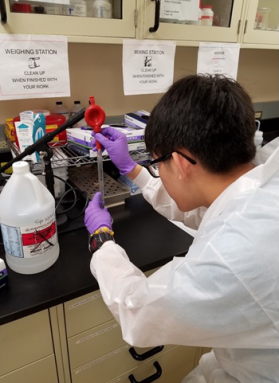
Biochar has its benefits, but it doesn’t absorb phosphate or nitrate. Layered double hydroxides (or LDHs) are chemicals that contain pairs of positively charged atoms. These may be magnesium and aluminum, for instance, or magnesium and iron. Their positive electrical charge lets LDHs attract negatively charged chemicals, such as phosphate. But LDHs aren’t very efficient at this. On their own, Stefan says, they “form kind of a sludge.” That means the positively-charged sites won’t be exposed and able remove the phosphate.
The LDHs can’t spread out on their own into a single layer, which would be needed for them to filter out the phosphate. Biochar, however, does work well in filters. So Stefan hypothesized that if he could get an LDH to stick to biochar, the LDH would spread out in a thin layer. Then it should be able to remove the phosphate.
“By combining the two you kill two birds with one stone,” Stefan says. By that, he means, the biochar will be “making the LDH more viable, by spreading it out.”
To test his idea, the teen began by making combinations of biochar and LDHs. He tested two types of LDH. One contained magnesium and aluminum. The other had magnesium and iron. He put these into solutions of phosphorus and measured how much each mix could remove from the water.
The magnesium and aluminum pairing worked best. And the best recipe was made from 60 percent biochar and 40 percent of this LDH. It soaked up phosphate well. It became 95 percent saturated with phosphate in just one hour.
Stefan was curious whether the biochar mix could later release the phosphate it had taken up. Then that nutrient might be returned to the soil as a plant fertilizer. To test the idea, the teen prepared small cups of sand in which he would grow lettuce seeds. Some cups had only sand. These served as his control. The others also contained his phosphate-loaded mixture. After 12 days, the teen measured how big the lettuce seedlings had grown.
The seedlings grown in cups that also had the phosphate-loaded biochar were 20 milligrams (0.0007 ounce) heavier than those grown in just sand. The biochar had released some of the phosphate, which the lettuce seeds used to grow.
Stefan and three University of Florida scientists have just published the new findings in the March Journal of Industrial and Engineering Chemistry.
The next test will be to see if the biochar mix works as well on farms. “I still think more research needs to be done,” Stefan says. Another mix of LDH and biochar might work even better. Also, he only tested one kind of biochar. It had been made from bamboo. He would like to also test biochars made from sugarcane or hickory.
Once he’s done that, Stefan hopes to improve his water treatment. “[Phosphate] is a big contributor to eutrophication,” he explains. “But it’s not the only one.” He’d like to made a pollutant treatment that also can soak up nitrate.
This project shows that even teens can do research offering potentially important, real-world benefits.
Follow Eureka! Lab on Twitter

